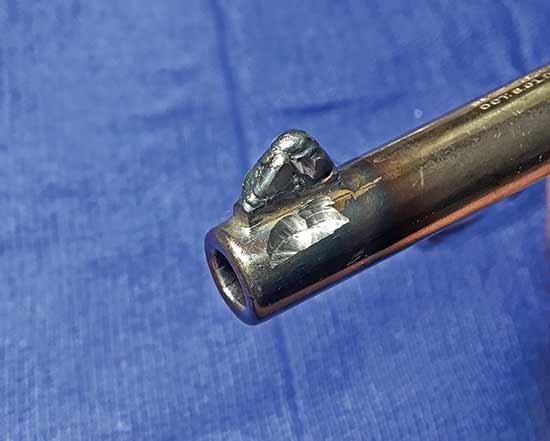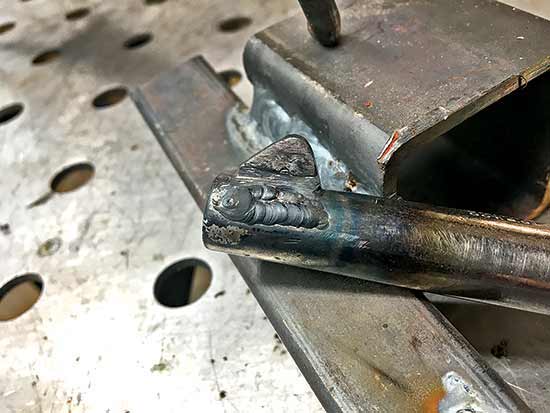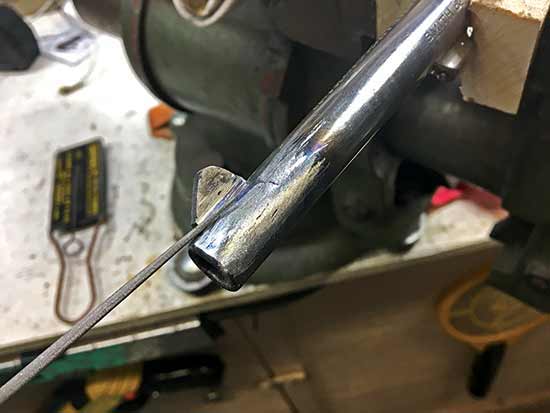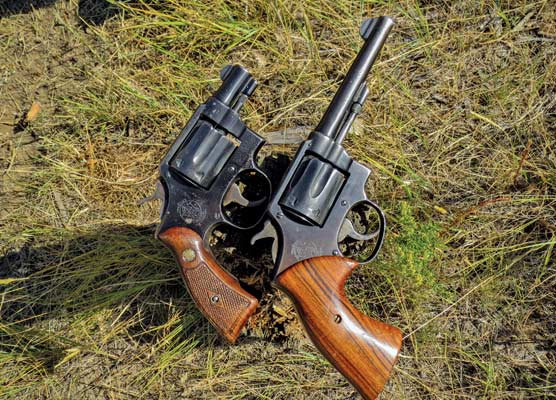An Oops... And A Recovery!
How Tig Welding Saved The Day
Not very long ago I stumbled onto a sort of “fixer” S&W Third Model Hand Ejector in .32-20. The nickel is worn, but once I cleaned her up some, tuned the timing a bit and re-cut the grip checkering (I covered that part in the Insider, Sept/Oct 2017) I wanted to modify the front sight. When I got it, it shot about a foot high at 15 yards and about a foot left. Since it wasn’t a minty-collectible I thought of TIG welding the front sight to add some height, then filing it down to the right height to bring the point of impact lower would make sense. I was also going to mill the rear sight slot wider — to the right more — to move the point of impact right some. I ended up doing that with tiny Swiss files.
I’ve been learning how to TIG weld over the past couple of years and have gotten to the point I can weld-up screw holes, sear tips, fill deep gouges and all those thousand other things a bit of accurate weld can help fix. I figured a simple weld to the front sight wouldn’t be an issue, and it wasn’t. I built up the top and added a bit to either side since the sight looked pretty banged-up. I thought I’d square things up and make it look nice in my mill.
While this goes a bit past “amateur hour” for hobby gunsmithing, some lessons I learned — yet again — are good to share. With the front sight welded, I locked it into my milling machine vise and carefully used an end-mill to shave off one side of the sight. All went just fine and I had a nice, clean, square cut. Moving the vise and re-indexing the cutter, I started to make the cut on the opposite side of the blade.
I’ll tell you now there was a little voice inside saying, “Hey stupid, I don’t think that’s secure enough, take the time to make sure.” But since I was taking what I thought were very light cuts, I thought “good enough” was, well … good enough.
It wasn’t.
As the bit turns it tends to want to “pull” down into the work if you’re using the side of the bit. Which is exactly what it did, only instead of the bit moving down (it was locked in the spindle and couldn’t) the barrel was “pulled” up, slipping in the vise, and the side of the barrel met the bottom of the end mill. I shoulda’ listened to that little voice. At that point, the end mill did what end mills do and cut some nice hunks out of the barrel. That’s the oops part.
I figured, no sweat, I’ll just get another barrel and chalk all this up to life experience. I called Nancy First at Jack First Gun Parts. They specialize in old/antique and hard to get parts — (605) 343-9544 if you need to call ’em. Nancy checked, but no 100-year-old S&W barrels in .32-20 were handy that day. Or most days, I found out, after calling a few other sources.
Since I had nothing to loose at that point, I took a deep breath and TIG welded the hole in the barrel, adding more to the base of the sight while I was at it. Then, since I had cold feet with the mill, I set to work with hand files slowly working everything back to where it should be. I finished up with wet-or-dry paper and did a final 400-grit finish. Then I used a nifty nickel plating kit I had on-hand to touch things up. It’s not something you’d want to nickel plate a whole gun with, but for screw heads, small tooling (and S&W front sights …) it works fine.
The end result doesn’t look too bad if you sort of squint, and it got the old gun shooting again. If you’ve never done it, you’ll be amazed at what you can do with slow, careful file work. Just take your time, and remember, unless you can weld, once you remove the metal you can’t put it back! I hope this pushes you to start some of your own projects. Just be smarter than I was — and listen to those little voices.
Let me know if you want to read about more adventures at my bench. Sometimes they actually come out just fine. No, really.
[email protected]









